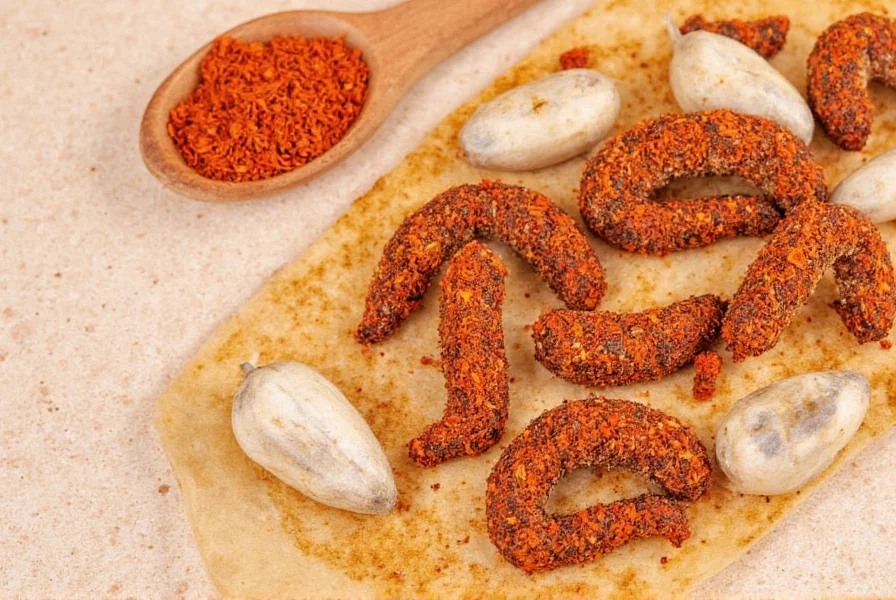Ajika: The Georgian Seasoning That's Spicier Than Your Ex's Texts
Table of Contents
- What is Ajika?
- Flavor Profile & Key Ingredients
- How to Use Ajika in Everyday Cooking
- Ajika vs. Other Global Spice Blends
- Buying Guide: Choosing the Best Ajika Blend
- Creative Recipe Ideas with Ajika
- Conclusion
What Is Ajika? A Taste of Georgia’s Fiery Soul
If you're into bold, vibrant flavors that punch you right in the taste buds (in the best way possible), ajika should already be on your spice rack—or at least on your radar. Hailing from the Caucasus region and most famously associated with Georgia, ajika is more than just a condiment—it’s a culinary identity.
Traditionally made from chili peppers, garlic, herbs like coriander and dill, along with salt and sometimes walnuts or spices like fenugreek, ajika comes in two main forms: red and green. Red ajika is the spicier version, often sun-dried before grinding, while green ajika leans fresher and herbaceous, using raw chilies for a more pungent kick.
The Flavor Profile: Heat Meets Herbaceous Harmony
Ajika isn’t just about heat—it’s a full-bodied experience. Here's what makes it stand out:
- Heat Level: Medium to extremely hot, depending on the pepper variety used (like the infamous khrdziani pepper).
- Herbal Notes: Coriander, dill, and marigold petals give ajika its unmistakable freshness.
- Umami Boost: Garlic and salt provide depth, making it an excellent pairing with grilled meats and stews.
- Nutty Finish: Some blends include crushed walnuts for texture and earthiness.
How to Use Ajika in Everyday Cooking
You don’t have to live in Tbilisi to fall in love with ajika. Here are five easy ways to incorporate this powerhouse seasoning into your everyday meals:
- Pasta Perfection: Mix a spoonful into tomato-based pasta sauces for a smoky, spicy twist.
- Grilled Goodness: Rub onto chicken, lamb, or vegetables before grilling for a flavor explosion.
- Stew It Up: Add a teaspoon to bean soups, lentils, or even shakshuka for a deep umami layer.
- Dip Upgrade: Stir into Greek yogurt, sour cream, or mayonnaise for an instant spicy dip or sandwich spread.
- Popcorn Surprise: Sprinkle lightly over freshly popped corn—trust us, it works!
Ajika vs. Other Global Spice Blends: How Does It Compare?
| Spice Blend | Origin | Main Ingredients | Heat Level | Best For |
|---|---|---|---|---|
| Ajika | Georgia | Chili peppers, garlic, coriander, dill, salt | Mild to Extreme | Meats, stews, dips, spreads |
| Harissa | Tunisia | Chili peppers, garlic, olive oil, cumin | Moderate | Tagines, couscous, roasted veggies |
| Gochujang | Korea | Fermented soybeans, glutinous rice, salt | Mild to Moderate | Marinades, stews, bibimbap |
| Sambal Oelek | Indonesia | Ground fresh chilies, vinegar, salt | Medium-Hot | Stir-fries, noodles, grilled fish |
Buying Guide: How to Choose the Best Ajika Blend
With so many brands entering the global spice market, choosing the right ajika can be overwhelming. Here’s a breakdown to help you pick the perfect jar:
Top 5 Ajika Brands You Should Try
- Tamada Ajika
- Type: Red Ajika
- Features: Sun-dried chilies, garlic, coriander
- Best For: Grilling, stews, meat rubs
- Target Audience: Serious home cooks and spice lovers
- Occasion: Weekend BBQs, cozy winter dinners
- Zedashebi Ajika
- Type: Green Ajika
- Features: Fresh green chilies, dill, marigold petals
- Best For: Fish dishes, vegetable sides, salads
- Target Audience: Light eaters and herb enthusiasts
- Occasion: Spring picnics, light summer fare
- Suneli Ajika
- Type: Red Ajika (spicy)
- Features: Smoked paprika infusion, added nuts
- Best For: Sandwiches, potato dishes, dips
- Target Audience: Urban foodies and street food lovers
- Occasion: Street-style eats and quick bites
- Mtsvadi Club Ajika
- Type: Classic Red Ajika
- Features: No additives, traditional preparation
- Best For: Authentic Georgian cuisine lovers
- Target Audience: Home chefs and culture buffs
- Occasion: Cultural events, themed dinner nights
- Oda Ajika
- Type: Mild Green Ajika
- Features: Balanced heat with herbal notes
- Best For: Kids, mild spice lovers, creamy pastas
- Target Audience: Families and beginner users
- Occasion: Family dinners, weeknight meals
Creative Recipe Ideas to Try with Ajika
Ready to elevate your kitchen game? Here are some unique ways to use ajika beyond the usual suspects:
- Ajika Roasted Chickpeas: Toss chickpeas with olive oil and a pinch of ajika, then roast until crispy for a snack that slaps.
- Spiced Hummus: Whirl a teaspoon into homemade hummus for a kick that'll keep everyone coming back for more.
- Smoked Salmon Spread: Combine with cream cheese, lemon zest, and dill for a luxurious appetizer spread.
- Meatloaf Magic: Mix into the meat mixture before baking for a rich, savory-spicy crust.
- Spiced Popcorn: After popping, drizzle with melted butter and sprinkle with ajika and Parmesan.

Conclusion: Why Ajika Deserves a Spot on Your Shelf
In a world where flavor fatigue is real, ajika is a breath of spicy, herby fresh air. Whether you’re roasting vegetables, grilling meats, or jazzing up your lunch wrap, ajika brings depth, character, and a little bit of sass to every dish.
From its Georgian roots to your modern kitchen, ajika is more than a trend—it's a timeless treasure. So go ahead, grab a jar (or two), and let this fiery seasoning take your cooking from “meh” to majestic.
Because sometimes, the only thing better than revenge is ajika.











 浙公网安备
33010002000092号
浙公网安备
33010002000092号 浙B2-20120091-4
浙B2-20120091-4